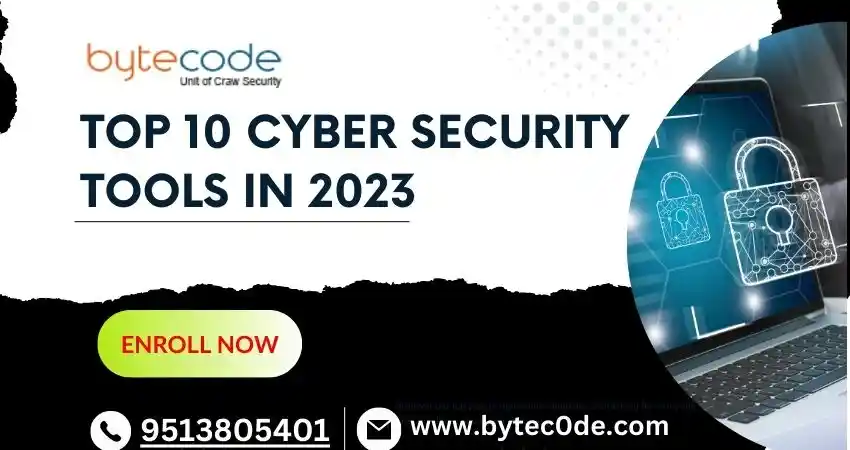Cyber Security Tools are used in order to get the best use of resources without being freaked out every time we hear about a cyber threat. Constantly the world is evolving on a digital level, whether it is technology or knowledge.
Here, in this article, we will be having a discussion about the Top 10 Cyber Security Tools in 2025 which have been in use to protect the confidentiality of the organizations’ resources. On top of that, what are the key features of those tools that help us to enhance our security measures? Without wasting any minute, let’s take a look at them!
What do Cybersecurity Tools do?
Cybersecurity Tools are specially customized software or tool that allows protection, prevention, detection, response, and recovery of data from the strong grip of adversaries’ attacks. The tools are essential for the CIA of a firm’s resources, such as.
- Confidential Data,
- PC,
- Networks, and
- System.
That is to protect them against it.
- Unauthorized Access,
- Malware Infections,
- Data Breaches, and
- Other Cybersecurity Incidents.
Top 10 Cyber Security Tools in 2025
- Firewalls
Network security depends on firewalls, which filter incoming and outgoing traffic in accordance with specified security standards. Examples of such firewalls include Cisco ASA, Palo Alto Networks, and Fortinet FortiGate.
Key features of firewall
- Packet Filtering,
- Access Control,
- Network Address Translation (NAT),
- Stateful Inspection,
- Application Layer Filtering,
- Virtual Private Network,
- Logging and Monitoring,
- Intrusion Detection and Prevention,
- Bandwidth Management, and
- Centralized Management.
2. Intrusion Detection and Prevention Systems (IDS/IPS)
IDS/IPS solutions like Snort, Suricata, and Cisco Firepower offer real-time oversight and defense against malicious activity and network intrusions.
Key features of Intrusion Detection and Prevention Systems (IDS/IPS)
- Traffic Monitoring,
- Signature,
- Anomaly-Based Detection,
- Deep Packet Inspection,
- Real-Time Alerts,
- Intrusion Prevention,
- Network Behavior Analysis,
- Event Correlation and Log Analysis,
- Threat Intelligence Integration, and
- Centralized Management and Reporting.
3. Antivirus and Anti-Malware Solutions
Norton, McAfee, and Kaspersky are popular antiviruses and anti- malware programs that assist in the identification, prevention, and elimination of dangerous software from computers and networks.
Key features of Antivirus and Anti-Malware Solutions
- Real-Time Scanning,
- Virus & Malware Detection,
- Quarantine and Removal,
- Regular Updates,
- Firewall Integration,
- Email Scanning,
- Web Protection,
- System Performance Optimization,
- Multi-Platform Support, and
- Additional Features.
4. Vulnerability Assessment Tools
Vulnerability scans are performed by programs like Nessus, Qualys, and OpenVAS to find security gaps, configuration errors, and well-known vulnerabilities in networks and systems.
Key features of Vulnerability Assessment Tools
- Scanning Capabilities,
- Vulnerability Identification,
- Risk Assessment,
- Continuous Monitoring,
- Patch Management,
- Compliance Checking,
- Reporting and Analytics,
- Integration Capabilities,
- Customization and Flexibility, and
- Vulnerability Trending and Tracking.
5. Security Information and Event Management (SIEM)
Splunk, IBM QRadar, and LogRhythm are examples of SIEM technologies that gather and analyze logs and security events from diverse sources to give centralized visibility and support incident response and threat detection.
Key features of SIEM
- Log Collection and Aggregation,
- Event Correlation and Analysis,
- Real-Time Monitoring and Alerts,
- Threat Intelligence Integration,
- Incident Response and Workflow Management,
- Compliance Monitoring and Reporting,
- Forensic Investigation and Log Retention,
- User Behavior Analytics,
- Integration with Security Tools, and
- Scalability and Flexibility.
6. Data Loss Prevention (DLP) Tools
By monitoring and regulating data access and usage, DLP systems like those from Symantec, McAfee, and Forcepoint assist organizations in stopping the unauthorized transmission or leakage of sensitive data.
Key features of Data Loss Prevention (DLP) Tools
- Data Discovery and Classification,
- Policy Creation and Enforcement,
- Endpoint Protection,
- Network Traffic Monitoring,
- Data Encryption and Tokenization,
- Incident Detection and Response,
- Cloud Data Protection,
- Data Visibility and Monitoring,
- Regulatory Compliance Support, and
- Integration with Security Ecosystem.
7. Encryption Tools
Data at rest and in transit can be encrypted to ensure confidentiality and integrity using encryption tools like Symantec Encryption, BitLocker, and VeraCrypt.
Key features of Encryption Tools
- Data confidentiality,
- Strong Encryption Algorithms,
- Symmetric & Asymmetric Encryption,
- Key Management,
- File & Folder Encryption,
- Secure Communication,
- Secure Storage,
- Password-Based Encryption,
- Integrity Protection, and
- Cross-Platform Compatibility.
8. Multi-Factor Authentication (MFA) Solutions
By requiring users to give multiple factors for authentication, MFA systems like Duo protection, RSA SecurID, and Google Authenticator add an extra layer of protection and lower the chance of unauthorized access.
Key features of Multi-Factor Authentication (MFA) Solutions
- Multiple Authentication Factors,
- Enhanced Security,
- Two-Step Verification,
- Adaptive Authentication,
- Integration Options,
- User-Friendly Experience,
- Centralized Management,
- Passwordless Authentication,
- Compliance & Regulatory Support, and
- Reporting & Audit Trails.
9. Security Orchestration, Automation, and Response (SOAR)
By integrating numerous security tools and orchestrating workflows, SOAR solutions like Demisto, Splunk Phantom, and IBM Resilient automate and streamline incident response operations.
Key features of SOAR
- Incident & Alert Management,
- Automation & Orchestration,
- Integration with Security Tools,
- Threat Intelligence Integration,
- Case Management and Collaboration,
- Playbook Creation & Customization,
- Metrics & Reporting,
- Incident Enrichment & Context Gathering,
- Compliance & Regulatory Support, and
- Continuous Improvement & Machine Learning.
10. Endpoint Protection Platforms (EPP)
By combining antivirus, anti-malware, and other security capabilities, EPP solutions like CrowdStrike Falcon, Symantec Endpoint Protection, and Carbon Black offer complete protection for endpoints (devices).
Key features of Endpoint Protection Platforms
- Antivirus & Anti-Malware,
- Real-Time Threat Detection,
- Endpoint Firewall,
- Intrusion Prevention System,
- Device Control & Application Whitelisting,
- Web Browsing Protection,
- Email Security,
- Endpoint Detection & Response,
- Centralized Management & Reporting, and
- Integration & Compatibility.
For such amazing information on cyber security course and technology, follow bytecode security.

